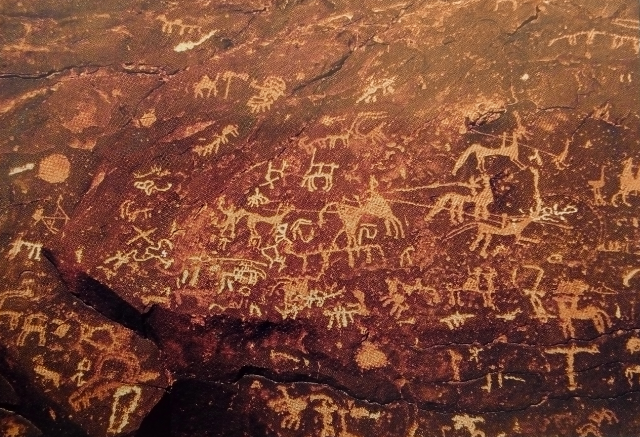
It is only recently that we became aware of the importance and the abundance of the petroglyphs heritage in Jordan, as new fields are now opened to investigations. While the Rock Art is already known and partly surveyed in the easy to access Wadi Rum, the Eastern Badia is newly explored by archaeologists who, aside to their researches on ancient settlements in the Harra, noticed uncountable petroglyphs. Out of the discoveries in those marginal areas as well as the undergoing surveys conducted in the South of Jordan, is emerging a huge heritage that was till now underestimated (below photos from author).
Eastern Desert, Jabal Qurma, ostriches herd petroglyphs 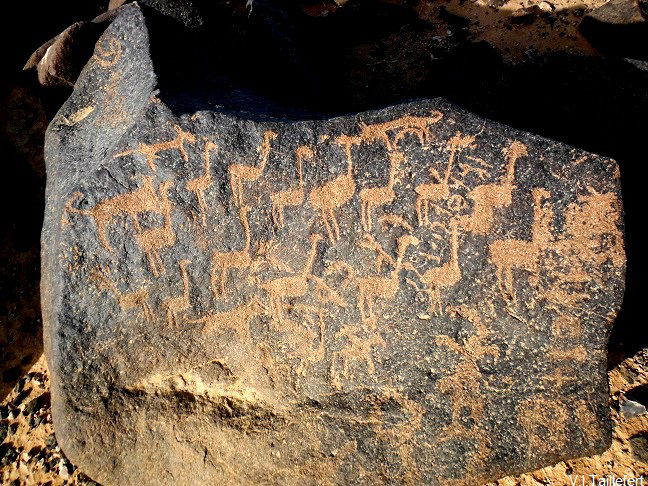 | Wadi Rum petroglyphs 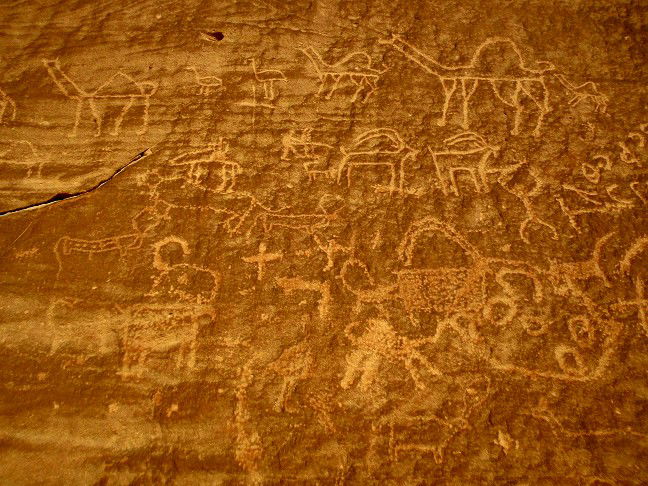 |
Middle East Rock Art outreaches borders of space and time. We speak about thousands and thousands of rock images and inscriptions stretching from Syria to Saudi Arabia, mainly through the basalt and sandstone areas. They attest to the presence and activities of nomadic and semi-nomadic peoples in those nowadays desert lands over a period estimated to 12 000 years, from the Neolithic (10 200 BC) till now, without interruption in certain areas like Wadi Rum. The Rock Art domain even extends far to East till beyond Iran. We are in front of a gigantic open-air library, that delivers information about environment, animals, humans, languages, scripts system, worships, historical events... beyond some local specificities and evolutions, the petroglyphs also put in light a common heritages and wide exchanges networks linking Middle East people throughout the ages.
Geographically, petroglyphs are not regularly spread through the domain. We generally find a higher density in connection with settlements, elevated places, hunting zones and water points. In the Eastern Desert, the till now recorded petroglyphs concentrations are mainly located in and around Jabal Qurma, Wisad pools, Wadi Qattafi and some spots in Ruwaished area.. In Wadi Rum however, the sites are more regularly spread, with a higher density at proximity of water sources. | 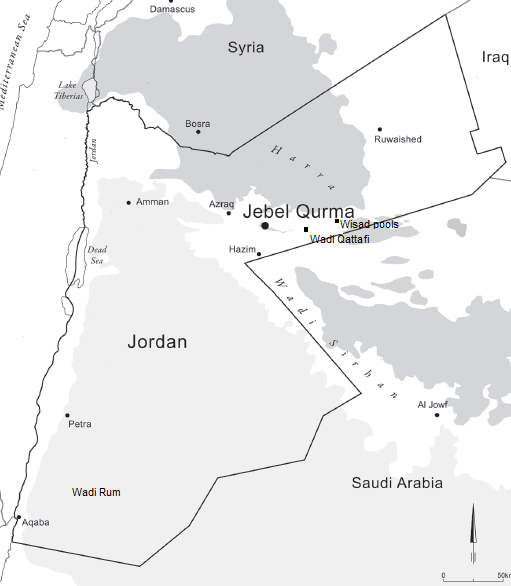 |
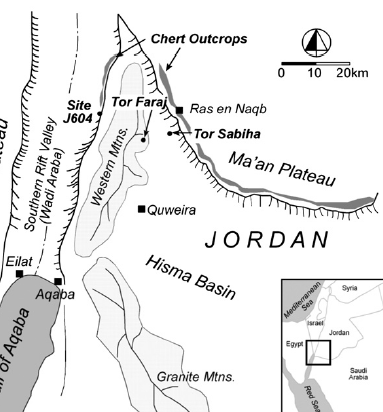 https://www.academia.edu/20422714/The_palimpsest_problem_hearth_pattern_analysis_and_Middle_Paleolithic_site_structure https://www.academia.edu/20422714/The_palimpsest_problem_hearth_pattern_analysis_and_Middle_Paleolithic_site_structure | Particularly prosperous in petroglyphs, Wadi Rum must be understood as part of a cultural zone extending to the North of Saudi Arabia, the Hisma desert that corresponds geologically to a low plateau starting on its northern side at the depression of Ras El Naqab and extending into Saudi Arabia. This area is the cradle of a culture of Arabic background called Hismaic, which developed a local specificities and script system derived from Thamudic. |
The geographical extension of the petroglyphic domain does not lead to a relevant differentiation in the imagery typology. However, some figures are more present is certain areas, as for example, the kites in the Eastern Desert, the hands in the Hisma area. Cattle seem absent in the Hisma desert while in the Wisad pools, humans are rarely represented. Regarding the inscriptions however, the geographical distribution is more evident, with a prevalence of Thamudic and Hismaic scripts in the Hisma Basin and of Safaitic in the Eastern Desert, among other scripts... (below photos from author)
Wadi Rum, Thamudic inscription | Eastern Desert, Safaitic inscription |
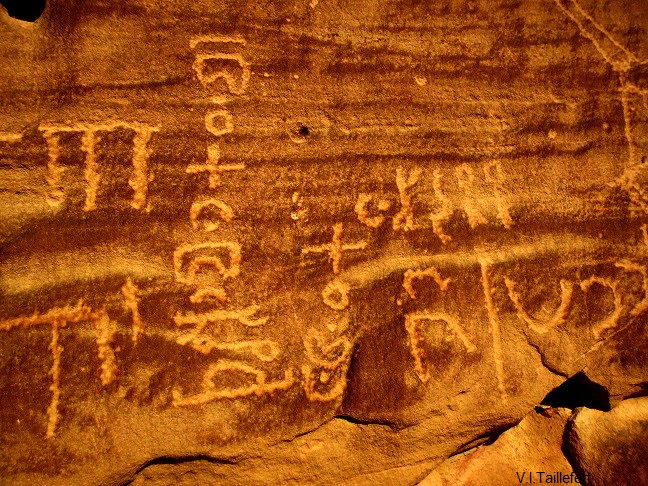 | 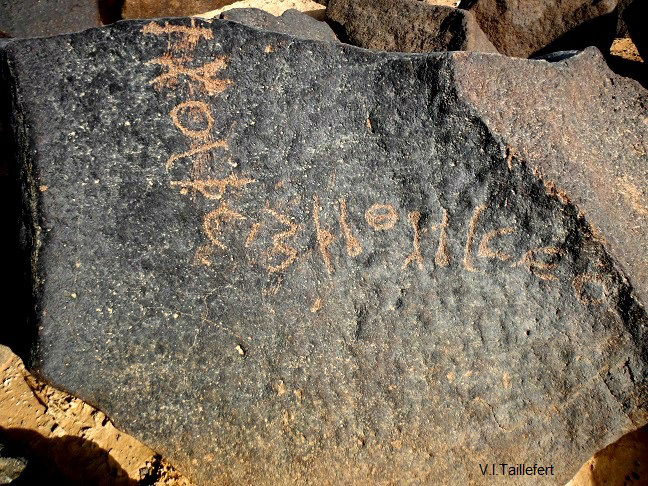 |
The Rock Art was practiced over all the periods and some specimen date to the 20th century, as this example of the electric pylon of the scene of the motorcycle accident, contingently interpreted as the fatal accident of Colonel Lawrence of Arabia (Wadi Rum, below images). Indeed, it would be erroneous to consider the petroglyphs as referring constantly to ancient periods.
Wadi Rum, electric pylon graffiti | Wadi Rum, reproduction of the graffiti depicting the so called "Lawrence's accident" |
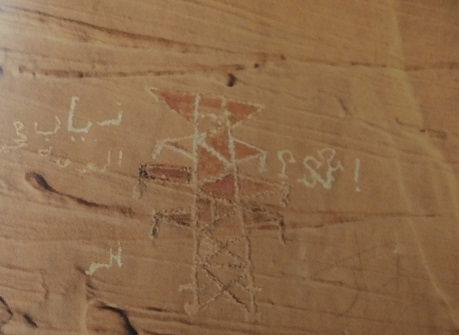 Borzatti ref. below |  Borzatti ref. below |
Moreover, nowadays, the modern tourism is adding its touch with the testimonies of foreigner visitors letting their names, their drawing tentatives, honeymoon testimonials... (below photos from author)
 | 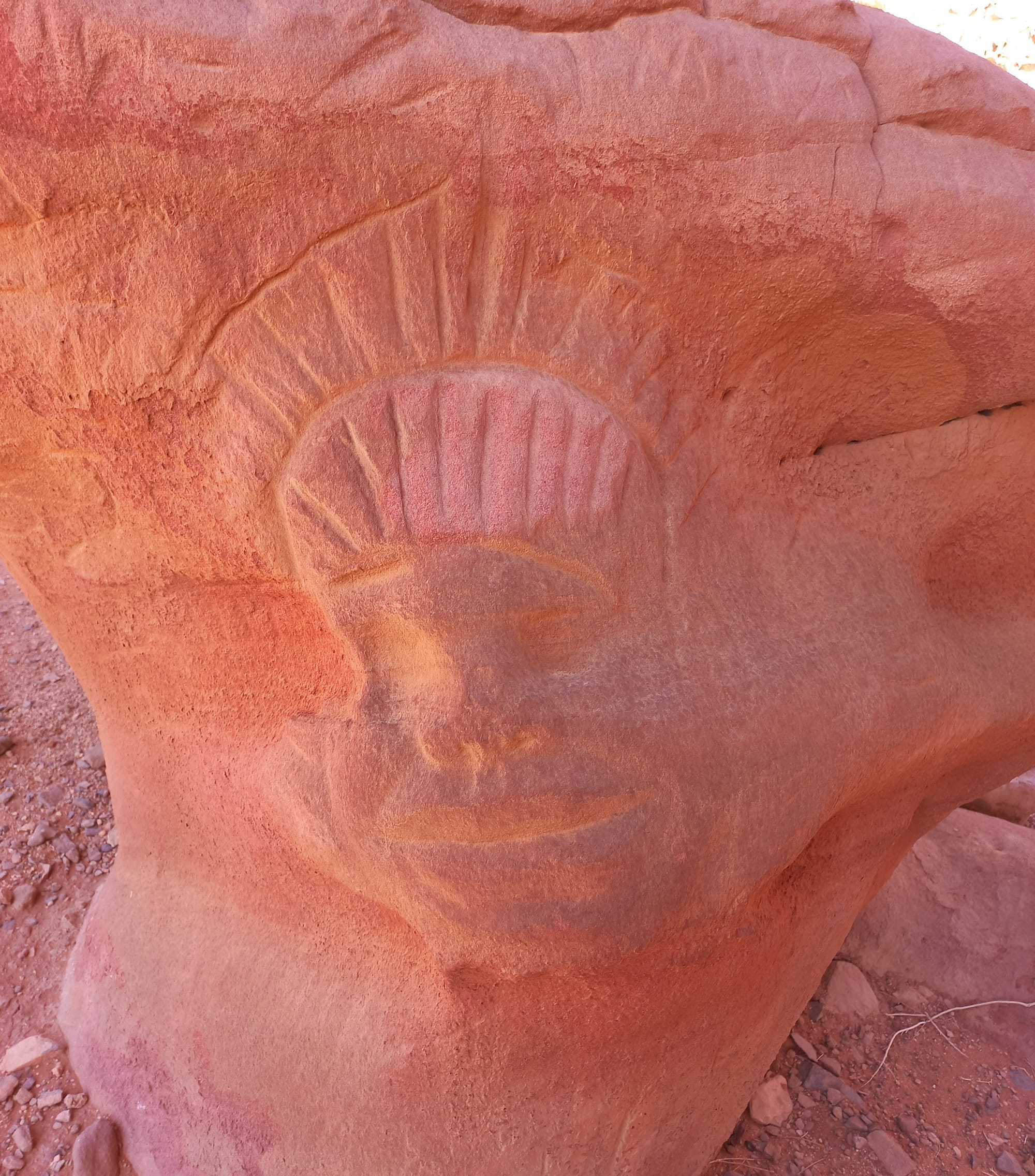 | 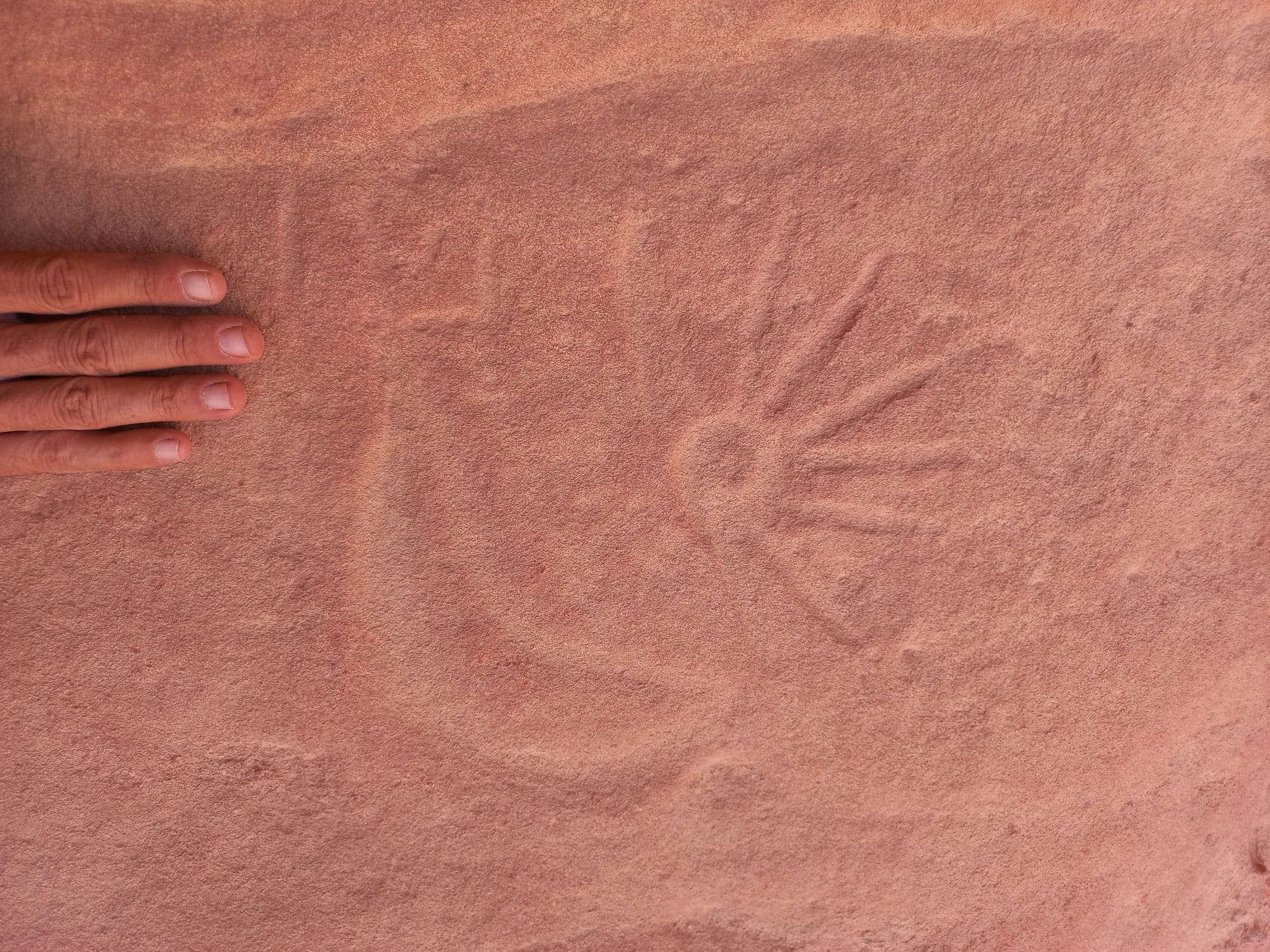 |
Scholars estimate the oldest Wadi Rum petroglyphs to 10 000 BC, while it seems that those of the Eastern Badia, in correlation with the settlements, could be starting from 8 000 BC. It happens often a surface to have been used and reused over the time, cumulating by this way the representations over several periods. Petroglyphs dating is very challenging, as long as we cannot find indicators in the representations themselves. Themes are strangely constant over time, at least in pre- and historical periods, with only a variation of some executive features. The following table mention some elements that can contribute to the Rock Art dating. (below photos from author)
external to the representation indicators | inherent to the representation indicators | ||
Patina and colour of the design: can give information about the synchronicity between designs or superposition. | 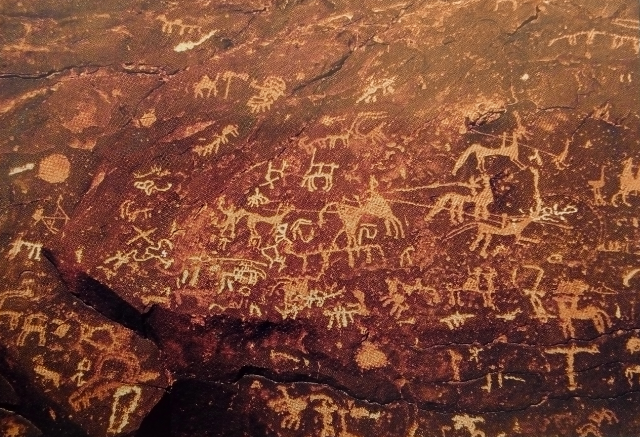 | Inscriptions: the alphabetic scripts do not appear before 3500 BC (Thamudic) and start to be popularly spread only at the 1st millennium BC. It is generally considered that the Thamudic inscriptions of Wadi Rum can not be dated before 600 BC. Safaitic inscriptions are estimated dating between the 1st century BC till the 4th AD. The scripts that link to modern Arabic appear later. The writing style may also give indications. Designs in relation with inscriptions can be relatively accurately dated. | 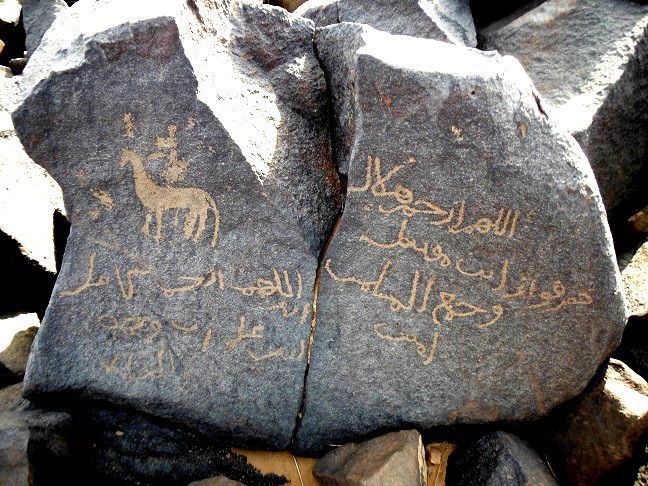 |
Technique of execution and engraving: Petroglyphs are carved by a plus or less superficial abrasion of the upper stone surface, or engraved in relief, scratched or even painted. A close survey of the used technique helps to determinate the temporal relations between different designs, but it can not give an absolute dating scale. | 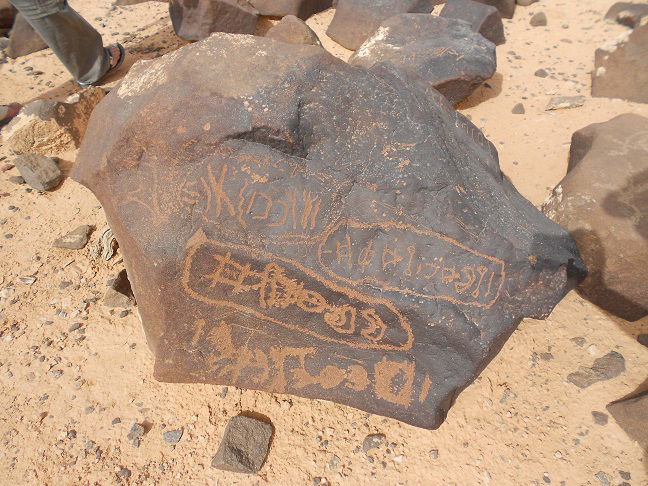 | Animals: a ridden dromedary can not be dated before 2000 BC and rather refer to a period after 1000 BC where those animals start to be commonly used for transportation. An ostrich can not belong to a recent time as this long ago common species extincted in the concerned areas. | 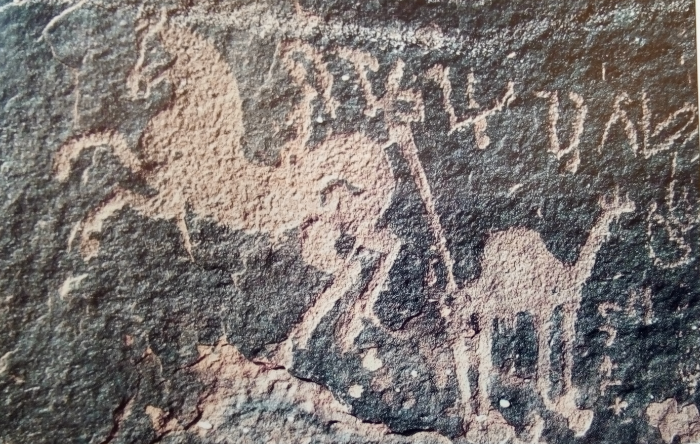 |
Association with close settlements: for example, animal bones found in a settlement may support the dating of a related design representing the same animal. | 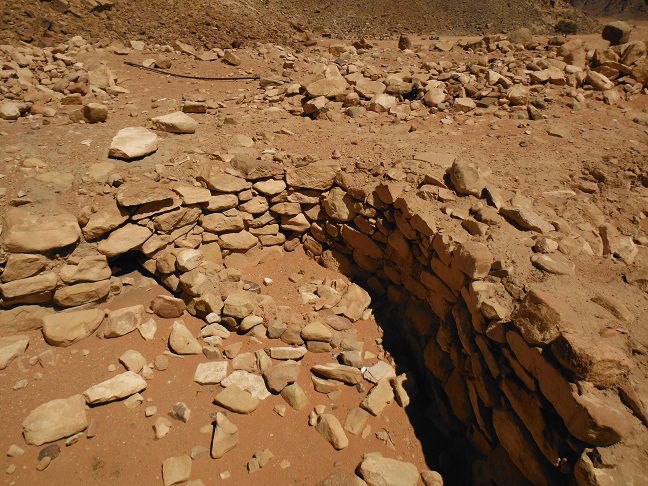 | weapons: for example guns refer to the Arab Revolt period or later. A sword or a round shield can not belong to the Neolithic period... | 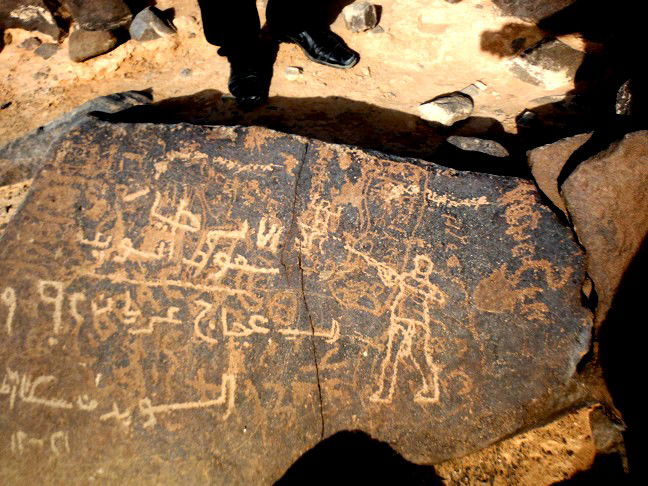 |
Specific scenes (hunting, fights, wars): for example, kites are mostly associated to the Neolithic hunting practices. Fighting scenes on camels or horses refer naturally to historical times, while guns shooting belong to the end of Ottoman occupation. | 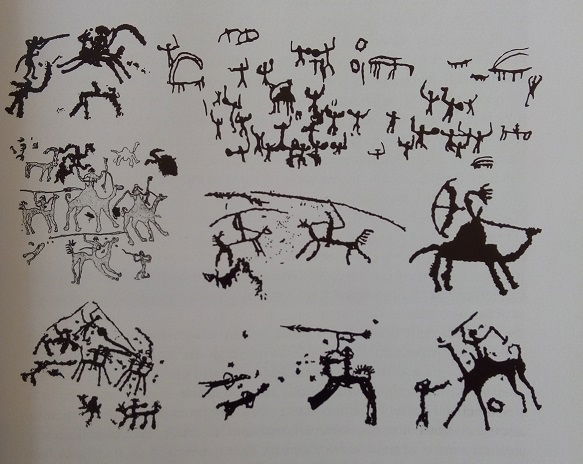 | ||
The scenes and testimonies delivered through the Rock Art are very diversified and belong to different registers: while some representations may refer to sacral spheres, to religious or / and funeral rituals, others contain elements that impressed humans, as for example specific animal species, and others belong to a profane, even sometimes trivial, register. Not all petroglyphs should be interpreted as substantial messages. Some of them may have been performed as a pastime, an artistic expression, a personal experience or adventure remembering. Others are effectively messages let to the further occupants of the place, as those which indicate the localisation of sources or direction. Still others are to be interpreted as identification signs, the tribe symbols or the ownership statement. This wide diversity makes the study field fascinating and the exploration extremely broad. (below photos from author)
Wadi Rum, one of the rare depictions of bird | Eastern Desert, Jabal Qurma, camels with inscriptions |
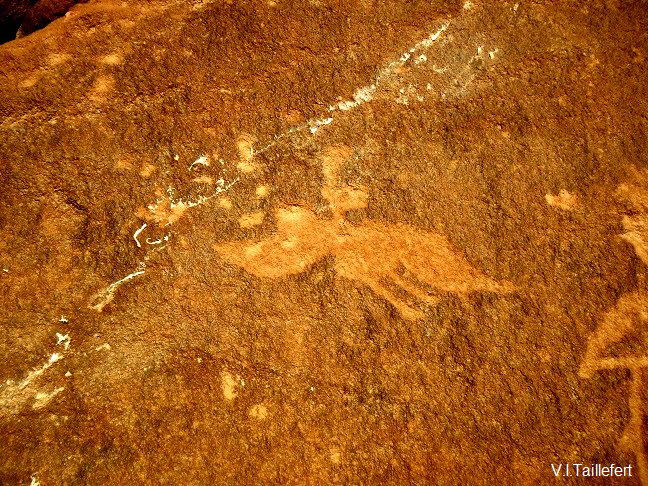 | 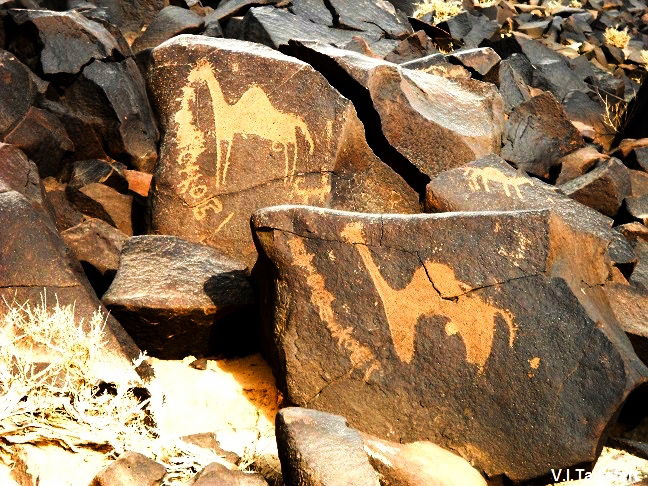 |
References:
Edoardo Borzatti von Löwenstern : Quadri Di Pietra, 8000 Anni D’Arte Nel Deserto, Casa Editrice Nuova, Bologna 2005.
Saba Fares-Drappeau : La Representation De La Main Dans Les Gravures Rupestres En Jordanie Eu Sud, Journal of Epigraphy & Rock Drawing, 2008/2, Department of Antiquities, Amman 2018.
A.Betts, S.Helms: https://www.persee.fr/doc/paleo_0153-9345_1986_num_12_1_4400
Bryan C. Gordon: www.researchgate.net/publication/281905254_A_NEW_METHOD_FOR_DATING_PICTOGRAPHS_AND_PETROGLYPHS_USING_FALLEN_PIGMENT_AND_STONE_DUST_IN_THEIR_UNDERLYING_SOIL
Yorke M. Rowan, Gary Rollefson, Alexander Wasse, Austin “Chad” Hill, Morag M. Kersel: https://www.researchgate.net/publication/317556105_The_Late_Neolithic_Presence_in_the_Black_Desert
Michael Macdonald, Norbert Nebes: krc.orient.ox.ac.uk/resources/publications/macdonald/Ancient%20Arabia%20a%20Brief%20History%20and%20Time-Line.pdf
Thomas R. Paradise: www.academia.edu/7276357/Analysis_of_sandstone_deterioration_on_petroglyphs_architecture_inscriptions_and_dressed_surfaces_across_Wadi_Rum_Jordan
Mahdi Alzoubi, Sultan Al-Maani and Hussein Al-Qudrah: https://eis.hu.edu.jo/deanshipfiles/pub103637023.pdf
UNESCO / ICOMOS: https://whc.unesco.org/document/152516
Azhideh Moqaddam: www.bradshawfoundation.com/middle_east/ancient_geometry/index.php and http://www.bradshawfoundation.com/middle_east/saudi_arabia_rock_art/footprints_handprints.php
www.toskana-art.it/borzatti/giordania.htm
www.wadirumprotectedarea.com/petroglyphs-rock-art-wadi-rum
https://en.royanews.tv/news/14676/7000-year-old-feline-petroglyphs-discovered-in-Jordan